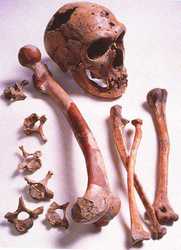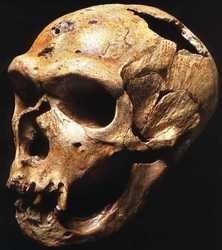By
James Zaworski
Neandertals are hot again, and in the news. The genome of the Neandertal has been sequenced and the results are in. Their DNA has been compared to ours, and I’ll put in links to the science stories that will give those results at the end of this review.
Neandertals have always fascinated me, ever since I learned that “another” species of human had existed. I learned this when at the tender age of about six, and my oldest brother had told me about these mysterious Hominids. Who were the Neanderthals? How long ago did they live? What were they like? Were they really dim witted brutes who were outwitted by our ancestors, and doomed to extinction? Or, were they very close to us, and did they play any part in the ancestry of modern humans?
NOVA produced a very good documentary on Neandertals in 2002, and though a little dated, is still an excellent overview of the controversies and questions surrounding this, our sister species and closest relative.
NOVA is one of those science documentary programs aired on PBS that attempts to look at “both sides of the coin”, as it were. Evidence is presented, and two or more interpretations of the same evidence is presented as well, and it is the viewer who is the one who is to make up his own mind and draw his own conclusions based on that evidence, and, of course, further research. NOVA is an excellent series that can be used in the classroom quite well, to augment many different types of science courses: in this case, biological evolution, paleoanthropology, archaeology, and genetics.
What follows is a synopsis of the program with the major arguments for Neandertals being very close to our species and the arguments against Neandertals being close to our species. Note that I am opting to use the spelling “Neandertal” which best represents the pronunciation of the name, and the program uses the older spelling of “Neanderthal” (“thal” means valley in German, and is pronounced “tall”).
Synopsis( with analysis ).
The documentary begins with a cave where, 28,000 years ago, the last Neandertals lived. For 200,000 years, Neandertals lived and survived in ice age Europe. Newcomers had arrived, who were somehow more successful than Neandertals, whose numbers dwindled, until they finally vanished and the world belonged to one species, our own. We forgot about the Neandertals for about 30,000 years. Until in the late 19th century(1856), bones were found in the Neander Valley in Germany.
Who were these people? Their status has ebbed and flowed back and forth in a seemingly endless debate about where they fit in our family tree. The first few fossils were thought to be of some Cossack who got lost during Napoleons retreat, or that this was truly the “missing link” between apes and humans. As more fossils were discovered, other interpretations were made. The most influential interpretation of a find, that has stigmatized Neandertals in popular imagination, is that of the stooping, brutish, dimwitted “cave man”, who dragged his woman by the hair to the cave to satisfy his animalistic and carnal desires. The specimen in question was the “old man of La Chapelle”, and the paleontologist who made this interpretation was Marcelle Boule. Boule’s examination did not take into account that this specimen, an edentulous and geriatric individual, was suffering from severe arthritis, rickets and a club foot! Had a younger, healthy specimen been the full type specimen for Neandertal, that interpretation would most certainly have been different.
The bones are being subjected to DNA tests. Svante Paabo, a paleoanthropological geneticist, is beginning a series of genomic tests on the surviving DNA in Neandertals. At the time of this film, only mitochondrial DNA could be extracted from ancient bones more than, say, 25,000 years. Nuclear DNA tends to degrade rapidly under normal circumstances, and the difference between the two is that the instructions that make you, you come from the nuclear DNA (from the nucleus of the cell), and the mitochondrial DNA, which is only inherited from the female line, code for various protein synthesis in the cell. It is theorized that the rate of mutation in mitochonidrial DNA is contant and thus predictable and measurable, but this is only a theory that has not been demonstrated to the satisfaction of all. Rates of mutation are likely to be variable, so predicting how old a species is, or our supposed divergence from that species, is dependent on a “molecular clock” that probably needs a new battery or needs to be wound more often. Regardless, the mitochondrial DNA was sequenced from Neandertals and was compared to 1000 modern people. The difference between modern populations was 8 mutations, giving us a common ancestor about 150,000 years ago. The difference between Neandertal mitochondrial DNA and all modern populations was 26 mutations, and that we diverged 500,000 years ago.
This first comparison reinforces the interpretation of Ian Tattersal and Chris Stringer, who feel that Neandertals were too different from our species to be considered the same species at all, and that, therefore, we were too different to interbreed. He, and others who agree with him, is that the Neandertals were completely replaced by our species. He further argues that anatomically and culturally, and in the archaeological record as well.
The flip argument is presented by Eric Trinkaus, who argues that we were close enough to interbreed, and that he has proof from a site in Spain, a hybrid between Neandertal and modern human: a child, who died about 25,000 years ago, some 3,000 years after Neandertals were supposed to have died out.
The anatomical features are completely a ‘mosaic’ of features, ‘modern’ and ‘Neandertal’. Other paleoanthropologists have concurred. This ‘hyrbridization’ is called admixture. Skeptics disagree, and say that the morphology is just a chubby or ‘stocky’ child.
Does the argument, and the stereotype go deeper? Is our view of Neandertals skewed by the ideas that we are the “artist” and they , the “beast” part of our nature? Has the interpretation by Boule biased a whole school of paleoanthropologists, who, as anthropologists should see the dangers in discriminating about subtle variations in characteristics? (see Stephen Jay Gould’s book “The Mismeasure of Man) Should we include, as Milford Walpoff thinks, that Neandertals should be included in our larger family, as part of our species?
We go back and forth in the argument. Specimens from Shanidar Cave, Iraq show a different face of Neandertal. An old man who had healed wounds that would have left him a total invalid, show that he was taken care of by family members. A burial was discovered here with a flower burial, as the pollen grains suggested, Neandertals were then given the status of “flower children”, caring and compassionate, and put in our lineage once again.
But, the ‘out of Africa’ theory began to take hold, and Neandertals seem to have evolved independently and then were thought to have been “replaced” by our species. But, did they interbreed? Could they?
Did they have language? Could they think? Was their stone tool technology sophisticated enough to be considered to be “modern”? Could the features that we see on Neandertals bones, particularly the skull, important enough distinctions to distinguish them as separate species? (Think of finding the full skeleton of a Chihuahua dog and a Great Dane dog, and you have never seen either, never in a hundred years would you think that they were the same species, just that certain traits were selected by human breeders of hundreds of generations and that in reality, they could interbreed and have puppies).
Neandertal specimens are more robust than modern humans, they had a longer and lower cranium and, on average, a larger brain size, in terms of cranial capacity. However, the interesting thing is that the similarities between Neandertals and modern humans are impressively great. Postcranially, we are very similar, in fact, nearly identical. Other than general robusticity, our bodies from the neck down are the same.
Now, Neandertals ranged from western Europe “Classic Neandertals”, which were very robust, ‘cold adapted’ humans who evolved and thrived in isolation during the ice ages and interglacial periods. However, when you look at the Neandertals from eastern Europe and the Middle East, especially from present day Israel/Palestine, you get less robust specimens, who fall in modern human variation in terms of the morphology of the bones. And, the stone tool technology that Neandertals used was Mousterian, and “modern” Cro-magnon sites from Europe are associated with the same stone tool technology, as are the “modern” human specimens from the Levantine Middle East. There, they lived side by side with shared culture, shared morphology, shared space and shared time (they overlapped from 100,000 to 42,000 years BP). A side note: I wrote a thesis paper that argued that if you have these four shared elements, that you have a population (Zaworski, 2004).
Back to the story, the comparisons of archaeological sites and morphological traits, and the questions that we ask about them and the answers we come to as a result of these questions, are examined. A wonderful and poignant segment of the documentary come from Professor Harold Dibble, who looks at “types”, and with bones and with stone tools. He gives two demonstrations, first, with a groups of pencils that have been sharpened, but are of a variety of lengths, and what if you discovered them and had to “classify” them. You could classify them according to size, but they are all still pencils. His second demonstration is with flint knapping, and he demonstrates that one can go through the whole series of ‘evolution’ in terms of types. One argument goes that modern humans would go up to 100 km out of their way to get premium flint, whereas Neandertals would use what was around locally, and get by just as well. That the modern humans would go out of their way to get ‘premium’ materials is supposed to demonstrate our “superiority in intelligence”, and the Neandertal use of what was on hand proved their “inferiority”.
The program ends with the debate still lingering, and unanswered.
However, Svante Paabo and his crew at the Max Planck Institute has sequenced Neandertal nuclear DNA, and compared their DNA with ours. Unlike the mitochondrial DNA, Neandertal DNA exists in each and every one of us! The statistic is, 1-4% of our DNA is distinctive Neandertal DNA! Please see the scientific links below for further reading as well as the news links (in the comments section)
All in all, NOVA’s “Neanderthals on Trial” is an excellent, thought provoking, educational and stimulating documentary. It is a program that is still valid today, and the Neandertal debate is ongoing, even though the genetics has irrefutably proved that Neandertals interbred with our species, and thus, we are the same species, not producing sterile offspring but fertile offspring. It’s a pretty fascinating story, and should be the story of the century.



 RSS Feed
RSS Feed